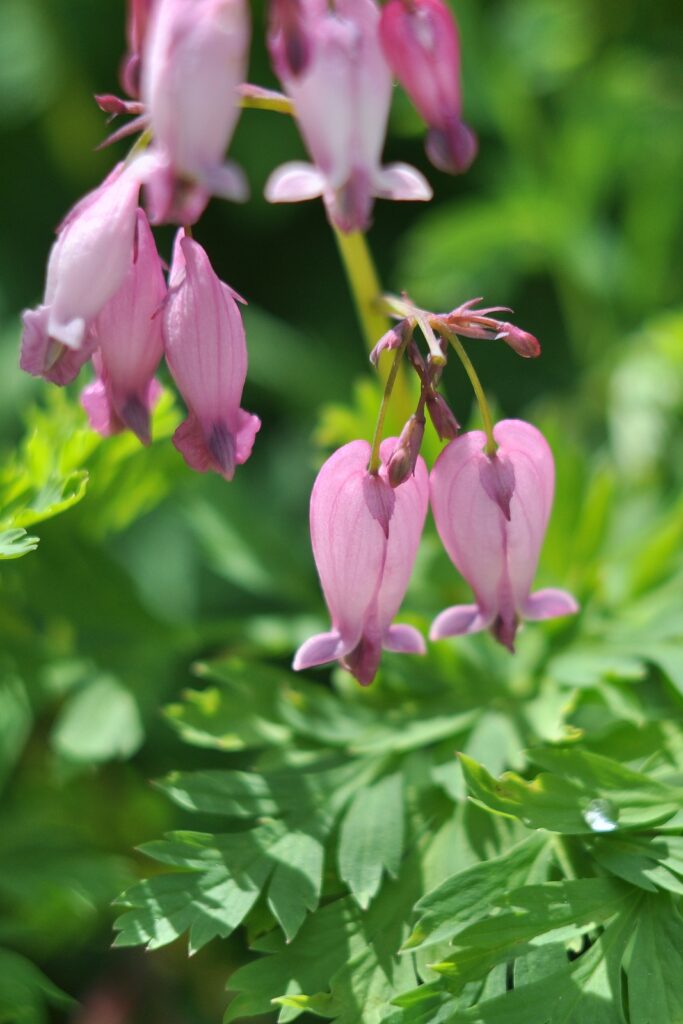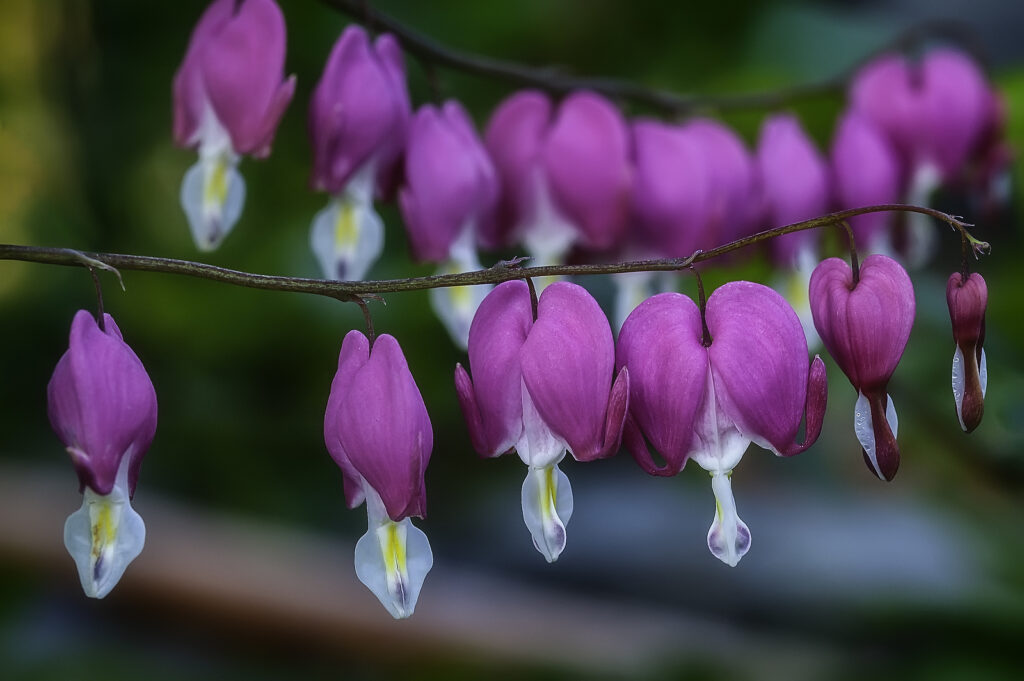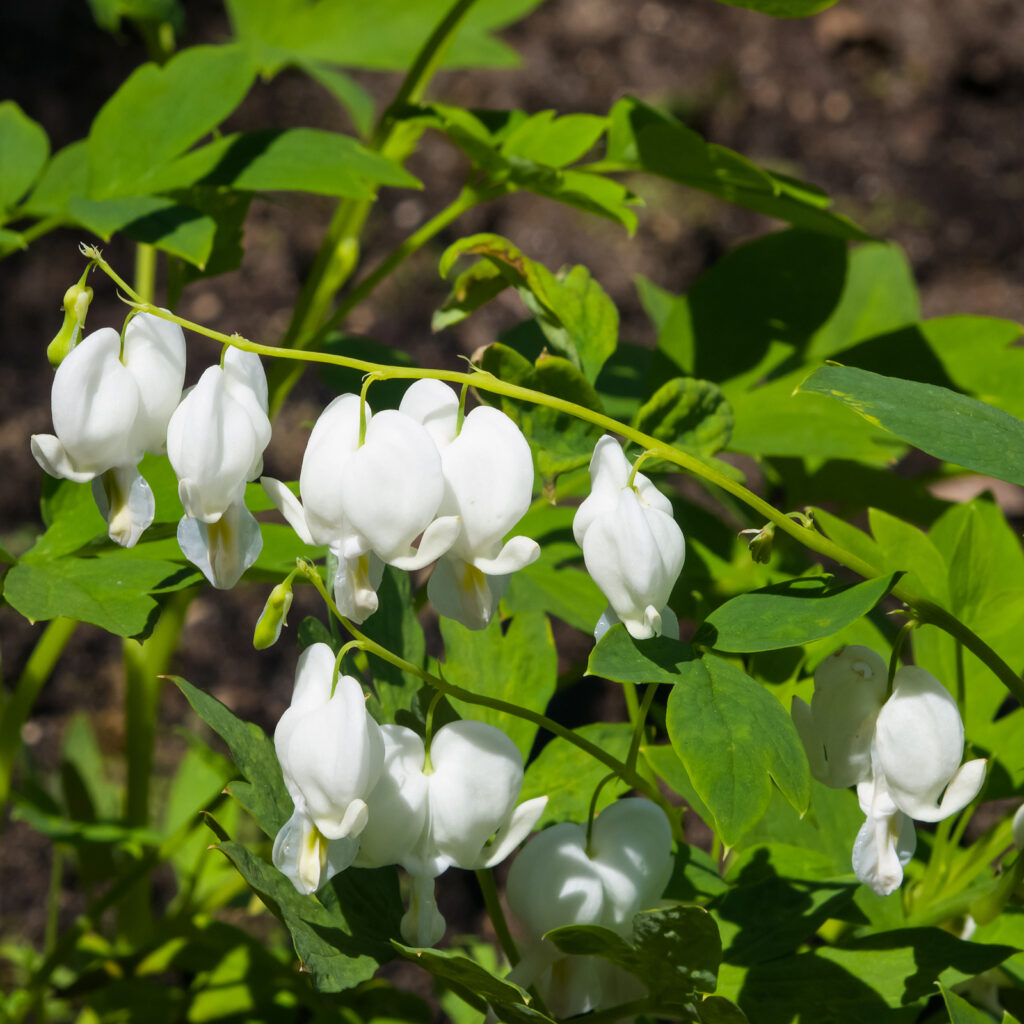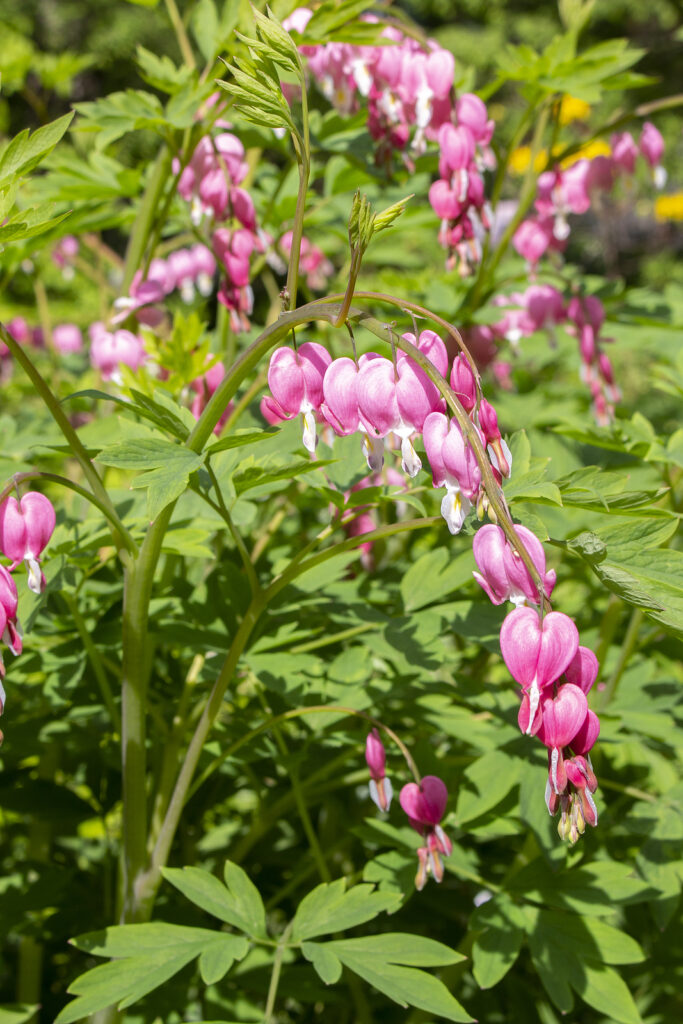Dicentra, commonly called bleeding heart, is a genus of annuals and perennials prized for their graceful, pendant, heart-shaped flowers. Bleeding hearts bloom from late spring to early summer depending on the variety. Blooms can be pink, red-pink, white, yellow, or purple depending on the variety.
Dicentra flowers have more or less heart-shaped corollas. The flowers have two petals that are modified into pouches or spurs. Flowers appear on long stalks above deeply cut, fernlike leaves. The green leaves become autumnal yellow after the blooms have faded.
Garden Success Products at Amazon:
- 10 pcs Stainless Steel Garden Hand Tool Set
- Flexi Hose with 8-inch Nozzle
- Gorilla Cart 4 Cu. Ft, 300-pound Capacity
- Neem Bliss 100-% Cold Pressed Neem Oil
- Safer Brand Insect Killing Soap
- Wildflower Seed Mix Attracts Hummingbirds and Butterflies
- Eden Brothers All Perennial Seed Mix
Dicentras are mostly native to lightly shaded woodlands in North America and eastern Asia. There are about 20 species; most are perennials, some are annuals.
Grow Dicentra toward the front of beds and borders. They are a favorite in cottage and woodland gardens. They are a good choice for planting alongside spring-flowering bulbs or hardy ferns. The flowers are excellent for cutting.

Get to know Dicentra — bleeding heart
- Plant type: Hardy perennial
- Growing Zones and range: Zones 3 to 9
- Hardiness: Hardy to -35°F (-37°C); tops of plants will die back with frost; heat tolerant
- Height and width: 24 to 36 inches (61-91cm) tall and wide, depending on the variety
- Foliage: Deeply cut, fernlike leaves
- Flowers: Pendant heart-shaped flowers with projecting tips
- Flower colors: Pink shades, red, white
- Bloom time: Early spring and on to fall in many locations; bloom time depends on the variety
- Uses: Beds and borders, shade garden, cottage garden woodland garden
- Garden companions: Hostas, daffodils
- Common name: Bleeding Heart
- Botanical name: Dicentra spp.
- Family: Fumariaceae
- Origin: Asia and North America

Where to plant Dicentra — bleeding heart
- Grow Dicentra in full sun to light shade in Zones 3 to 5; plant in light shade in Zones 6 to 9
- Plant Dicentra in humus-rich, well-drained soil adding plenty of aged compost at planting time.
- Dicentra prefers a soil pH of 5.5 to 7.
Dicentra uses and companions
- Dicentra will add beauty to shade gardens and woodland gardens.
- Plant Dicentra in shady borders; smaller species will look good in a rock garden.
- Good garden companions for Dicentra include Bergenia, Digitalis, Epimedium, Helleborus, Hosta, Mertensia, Primula, Trillium.
When to plant Dicentra — bleeding heart
- Sow seeds outdoors in late fall in evenly prepared soil; seeds can be started in flats in fall and left outdoors in an unheated place for spring germination.
- Set established plants in the garden in spring or fall.
Planting and spacing Dicentra — bleeding heart
- Sow Dicentra seed outdoors in evenly prepared soil; cover seeds lightly with soil.
- Seeds sown in flats can be left in an unheated place through winter for spring germination. Seedlings will be much smaller than plants you would purchase at a garden center.
- Set Dicentra plants outdoors in spring; cover the crown of the plant with 1 inch (2.5cm) of soil.
- Space Dicentra 12 to 36 inches (30-91cm) apart depending on the variety.

How to water and feed Dicentra
- Keep the soil evenly moist, especially in the first growing season.
- Water plants every 10 days during dry periods in spring and summer.
- Side dress Dicentra with aged compost or slow-release organic fertilizer in spring and again in autumn.
Dicentra — bleeding heart care
- Mulch around Dicentra to keep the soil evenly moist, especially in full sun.
- Remove spent blooms to promote more blossoms.
- Protect plants in winter with a 3-inch (7.6cm) layer of chopped leaves heaped over the crown of plants in fall. Marke the location so you won’t disturb the plants through the winter.

Dicentra pests and diseases
- Dicentra can be prone to stem rot when grown in damp, poorly drained locations. Improve drainage by adding organic matter to the soil; avoid overwatering.
- Dicentra is rarely attacked by pests or diseases.
Dicentra — bleeding heart propagation
- Dicentra seeds will germinate in 3 to 4 weeks at 50° to 55°F (10°-13°C).
- Divide mature plants by cutting a small rooted stem from the outside of the clump in mid-spring. Replant immediately.
- Dicentra rarely needs to be divided; divide plants only for propagation.

Dicentra — bleeding heart varieties to grow
- Dicentra eximia, fringed bleeding heart. North American native wildflower to 18 inches (45cm) tall; bears racemes of pendent, heart-shaped pink flowers from spring to fall. Several hybrids include ‘Bountiful’ with rose-red flowers, ‘Luxuriant’ with cherry red blooms, ‘Snowdrift’ with white flowers, ‘Langgrees’ with white flowers.
- D. formosa, Western bleeding heart. North American wildflower to 18 inches (45cm) tall, spreads to 36 inches (91cm); 1-inch (2.5cm) long heart-shaped flowers from late spring to early summer. Zones 3-9.
- D. scandens, climbing bleeding heart. Climbing species to 36 inches (91cm) high; racemes of 1 inch (2.5cm) long yellow flowers in summer. ones 6-9.
- D. spectabilis, common bleeding heart. Is an old-fashioned variety blooming early spring to midsummer; bushy 18 to 30 inches (45-76cm) tall; clumps spread; bears arching racemes of dangling heart-shaped flowers in rosy pink, rose-red, or white for a few weeks in spring. Zones 2-9.
Dicentra Frequently Asked Questions
Q: What are the cultural requirements of bleeding-hearts?
A: Dicentra doe best in light shade, although in cool climates they will grow in full sun. If planted in too deep shade, they will not bloom. Give Dicentra humus-rich, well-drained soil.
Q: How do I propagate Dicentra?
A: Propagate Dicentra from seeds, plant division, or stem or root cutting. Do divisions in early autumn.
Q: I mulched Dicentra with leaves last winter, but the plant died. What happened?
A: A mulch that is too thick can smother Dicentra, or you may have covered the plant too early. Wait until the soil is frozen before covering the plants lightly. Remove mulch gradually in spring. It is also possible that mice ate the roots.















